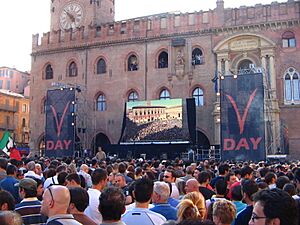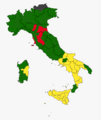Five Star Movement facts for kids
Quick facts for kids <div style="padding-top:0.3em; padding-bottom:0.3em; border-top:2px solid Lua error in Module:European_and_national_party_data/config at line 227: attempt to index field 'data' (a nil value).; border-bottom:2px solid Lua error in Module:European_and_national_party_data/config at line 227: attempt to index field 'data' (a nil value).; line-height: 1;">
Five Star Movement
Movimento Cinque Stelle
|
|
|---|---|
 |
|
| Abbreviation | M5S |
| President | Giuseppe Conte |
| Founders | Beppe Grillo Gianroberto Casaleggio |
| Founded | 4 October 2009 |
| Headquarters | Via Campo Marzio 46, Rome |
| Newspaper | Il Blog di Beppe Grillo (2009–2018) Il Blog delle Stelle (2018–2021) |
| Membership (2024) | |
| Ideology | |
| Political position | Left-wing |
| European affiliation | Five Star Direct Democracy (2019) |
| European Parliament group | EFDD (2014–2019) NI (2019–2024) The Left (since 2024) |
| Colors | <span style="background-color:Lua error in Module:European_and_national_party_data/config at line 227: attempt to index field 'data' (a nil value).; color:; border:1px solid darkgray; text-align:center;"> Yellow |
| Chamber of Deputies |
49 / 400
<div style="background-color: Lua error in Module:European_and_national_party_data/config at line 227: attempt to index field 'data' (a nil value).; width: 12%; height: 100%;">
|
| Senate |
26 / 205
<div style="background-color: Lua error in Module:European_and_national_party_data/config at line 227: attempt to index field 'data' (a nil value).; width: 13%; height: 100%;">
|
| European Parliament |
8 / 76
<div style="background-color: Lua error in Module:European_and_national_party_data/config at line 227: attempt to index field 'data' (a nil value).; width: 11%; height: 100%;">
|
| Regional Councils |
52 / 896
<div style="background-color: Lua error in Module:European_and_national_party_data/config at line 227: attempt to index field 'data' (a nil value).; width: 6%; height: 100%;">
|
| Conference of Regions |
1 / 21
<div style="background-color: Lua error in Module:European_and_national_party_data/config at line 227: attempt to index field 'data' (a nil value).; width: 5%; height: 100%;">
|
| Website | |
| Lua error in Module:European_and_national_party_data/config at line 227: attempt to index field 'data' (a nil value). | |
|
^ A: The M5S has been variously considered as left-wing or right-wing populist, as well as big tent populist and post-ideological. ^ B: The M5S has been described in news sources as both far-left and far-right, despite its rejection of the traditional left–right divide. Under Conte's leadership, the M5S started to identify itself as "progressive", but still alternative to the left-right schema. However, some observers have noted its shift to the left. |
|
The Five Star Movement (in Italian, Movimento 5 Stelle, or M5S) is a political party in Italy. It is currently led by Giuseppe Conte. The party was started on October 4, 2009, by Beppe Grillo, a comedian and activist, and Gianroberto Casaleggio, a web expert.
The M5S is often described as a populist party. This means it tries to appeal to ordinary people who feel that powerful groups are ignoring their concerns. The party also focuses on green politics, which means protecting the environment. It supports direct democracy, where citizens can vote on laws directly.
In the 2018 general election, the M5S became the largest single party in Italy. It formed a government with the League party, and later with the Democratic Party (PD). Giuseppe Conte, who was supported by the M5S, served as prime minister.
However, in the 2022 general election, the party received fewer votes and became part of the opposition. In 2024, the party decided to call itself a group of "independent progressives," showing a shift towards more left-wing ideas.
Contents
History of the Movement
How It All Started
The Five Star Movement began with online meetups. In 2005, comedian Beppe Grillo used his popular blog to encourage people to use social networks to organize local meetings. These groups, called "Friends of Beppe Grillo," discussed ideas for making the world a better place. They talked about topics like technology, the environment, and how to be a more responsible consumer.
These meetups grew, and soon they were holding national meetings. They discussed important issues, especially environmental ones, like finding cleaner ways to handle waste instead of burning it.
The V-Day Protests

On June 14, 2007, Grillo launched a major protest event called "V-Day." The "V" stood for several things, including a reference to the movie V for Vendetta, which the movement admired for its themes of political change.
The goal of V-Day was to collect signatures for a new law. This law aimed to clean up Italian politics by preventing people with criminal records from running for office. The event was a huge success, collecting over 330,000 signatures, far more than the 50,000 needed. A second V-Day was held in 2008 to gather support for other new laws.
From Civic Lists to a National Party
The movement started getting involved in local elections by creating "Five Star Civic Lists." These were groups of local candidates who shared the movement's ideas. On October 4, 2009, at a theater in Milan, Grillo and Gianroberto Casaleggio officially announced the creation of the national Five Star Movement.
The M5S quickly gained support. In the 2010 Italian regional elections, it won seats in several regional councils. By 2012, the party was winning mayoral elections in important cities like Parma. This success showed that the M5S was becoming a major force in Italian politics.
The 2013 General Election

In the 2013 general election, the M5S surprised everyone. It became the single most-voted-for party, winning over 25% of the vote for the Chamber of Deputies, one of the two houses of the Italian Parliament.
The party chose its candidates in a new way for Italy: through online voting by its members. After the election, the M5S refused to form a government with the other major parties and instead became the main opposition party.
The 2018 General Election and Government
The 2018 election was a huge victory for the M5S. Led by Luigi Di Maio, the party won 32.7% of the vote, making it the largest party by far. After weeks of talks, the M5S formed a government with the right-wing League party. Giuseppe Conte, a law professor supported by the M5S, became the Prime Minister.
This government, called the "Government of Change," introduced the M5S's key policy: a form of basic income called the "citizens' income" to help people living in poverty.
Government Crises and a Shift in Alliances
In 2019, the government with the League collapsed. The M5S then formed a new government with its former rival, the centre-left Democratic Party (PD). Conte remained as Prime Minister. This showed a major shift for the M5S, which had previously refused to make alliances with other parties.
In 2021, this government also ended, and a new "national unity" government led by Mario Draghi was formed. The M5S decided to support it, but this caused a split in the party. In July 2022, the M5S withdrew its support for Draghi's government, which led to its collapse and a new election.
The 2022 Election and a New Role
In the 2022 election, the M5S's support dropped to about 15%. The party did not join the new government and instead returned to being an opposition party. Under Conte's leadership, the M5S began to describe itself as a "progressive" force, focusing on issues like a minimum wage and protecting social programs.
What the Party Believes In
The M5S started as a "post-ideological" movement, meaning it didn't want to be labeled as just "left-wing" or "right-wing." Its main ideas are represented by its five stars:
- Public Water: Water should be a public good, not controlled by private companies.
- Sustainable Transport: Promoting public transport and cleaner ways to travel.
- Sustainable Development: Supporting economic growth that doesn't harm the environment.
- Right to Internet Access: Believing everyone should have access to the internet.
- Environmentalism: Protecting the environment and promoting a green economy.
The party strongly supports direct democracy and e-democracy, using the internet to let its members vote on important decisions and candidates.
Key Policies and Stances
- Anti-Corruption: The M5S has strict rules for its politicians. They cannot have a criminal record, and they are expected to serve only two terms in office before returning to their regular jobs.
- Environment: The party is against projects it sees as harmful to the environment, like certain high-speed rail lines. It supports renewable energy and "green jobs."
- Social Issues: The M5S supports same-sex marriage and laws to protect LGBTQ+ people.
- Immigration: The party's position on immigration has changed over time. It has sometimes taken a hard line, but at other times it has supported more welcoming policies.
Leadership and Organization
The M5S has a unique structure. For a long time, Beppe Grillo was the main leader and "guarantor" of the movement's principles. In 2017, Luigi Di Maio became the political leader.
After a leadership crisis in 2021, Giuseppe Conte was elected as the party's president. In 2024, the party members voted to remove the role of "guarantor," which ended Grillo's formal leadership role and marked a new chapter for the movement.
The party uses an online platform to allow its members to participate in decision-making. This is a key part of its commitment to direct democracy.
Election Results
Italian Parliament
| Election | Leader | Chamber of Deputies | Senate of the Republic | ||||||||
|---|---|---|---|---|---|---|---|---|---|---|---|
| Votes | % | Seats | +/– | Position | Votes | % | Seats | +/– | Position | ||
| 2013 | Beppe Grillo | 8,691,406 | 25.6 |
109 / 630
|
– | 7,285,850 | 23.8 |
54 / 315
|
– | ||
| 2018 | Luigi Di Maio | 10,732,066 | 32.7 |
227 / 630
|
119 |
9,733,928 | 32.2 |
112 / 315
|
58 |
||
| 2022 | Giuseppe Conte | 4,333,972 | 15.4 |
52 / 400
|
175 |
4,285,894 | 15.6 |
28 / 200
|
85 |
||
European Parliament
| Election | Leader | Votes | % | Seats | +/– | EP Group |
|---|---|---|---|---|---|---|
| 2014 | Beppe Grillo | 5,807,362 (2nd) | 21.2 |
17 / 73
|
New | EFDD |
| 2019 | Luigi Di Maio | 4,569,089 (3rd) | 17.1 |
14 / 76
|
NI | |
| 2024 | Giuseppe Conte | 2,336,452 (3rd) | 10.0 |
8 / 76
|
The Left |
Images for kids
See also
 In Spanish: Movimiento 5 Estrellas para niños
In Spanish: Movimiento 5 Estrellas para niños





